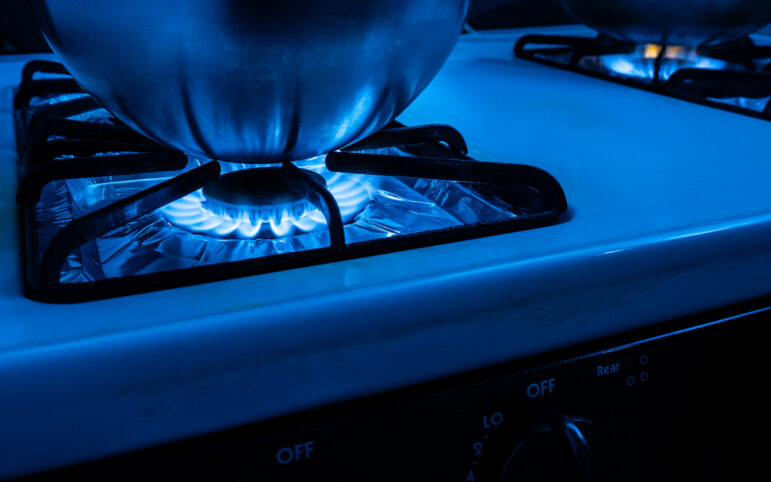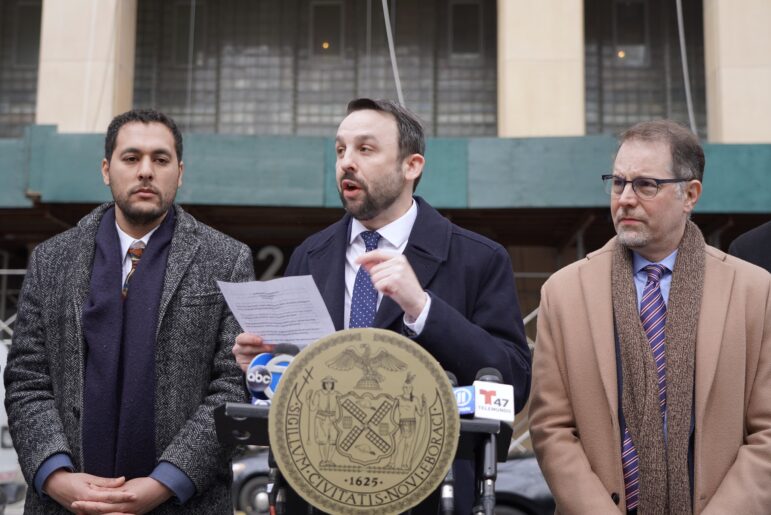
City Limits / Adi Talwar
Members of the the United Soccer Club playing at the Williamsbridge Oval Park in the Norwood section of the Bronx, where the club has played games for eight years.
Swing by Randall’s Island on a given night, and just a little of New York City’s sports diversity will be on display. Rugby on one field, soccer on another. Gaelic football over here, maybe Australian rules football over here. On a weekend day, the parade field at Van Cortlandt Park might offer a similar mix of team equipment: cricket bats, softball gloves, hurling sticks, frisbees.
All those teams and players combine to offer the city’s players an array of athletic options. But they also compete for access to that space.
In 2017, the city’s Parks Department issued 8,100 athletic permits for 877,000 hours of athletic time on its 800 ballfields—satisfying most but nowhere near all the demand for space. According to testimony at a 2018 City Council hearing on athletic field access, 600 athletic permit applications were turned down, representing 24 percent of requests.
There are indications that pressures around parks permits are increasing. The Parks Department instructs park users to call 311 and file a complaint for “obstructing public use” if they see someone using an athletic field without proper permits. While it’s possible that other types of complaints were also filed under that category, the number of “obstructing public use” complaints directed at the Parks Department via 311 so far this year is 11 percent higher than over the same period in 2018, and well above any year since tracking began in 2010.
| Calendar Year | Complaints to 311 about “Obstructing Public Use” in Parks |
| 2010 | 439 |
| 2011 | 388 |
| 2012 | 372 |
| 2013 | 221 |
| 2014 | 433 |
| 2015 | 369 |
| 2016 | 511 |
| 2017 | 487 |
| 2018 | 662 |
| 2019 | 734 |
Based on some of the conversations City Limits had with league organizers, coaches and players, it is becoming more difficult to get playing time, and sometimes permits are only available on a field that is inconvenient for players to reach.
Many of the leagues’ spokespeople said they appreciate the Parks Department’s efforts to issue permits as equitably as possible. Since 2012, Parks has moved from a paper-based to a web-based permitting system. But the coaches and commissioners we spoke with said the city could be doing a better job on two fronts: making the field permitting process less cumbersome and more transparent, and dedicating more resources and/or personnel towards permit enforcement to ensure that those leagues that applied for permits are actually playing on the field at the scheduled times.
A black market for ballfields?
At the April 2018 hearing, the Committee on Parks and Recreation’s then-chairperson Barry Grodenchik alleged that some leagues renew their permits year after year merely so they can sell them for cash to other leagues who are desperate for playing time. Parks’ First Deputy Commissioner Liam Kavanagh told the committee that the department had revoked 18 permits over the previous two years for those kinds of abuses, but testified that it was difficult for the agency to detect all under-the-table activity.
Sarah Hill co-founded with her husband the 5 Star Soccer Academy in 2016. She told City Limits that the exchanging of permits for cash is indeed happening at Flushing Meadows-Corona Park, where her husband provides soccer training to children and teenagers.
“The biggest issue is that Parks doesn’t have enough funding to scope out which leagues are misusing the permits that they do have. There’s a lot of demand, and there’ll be always be more demand than supply, but I think that there is still a lot of misuse of permits, even illegal activities,” she began.
“People have permits for years because it’s very easy when you have a permit, you are always kind of guaranteed to get that permit renewed without any real questions. So, a lot of times people are selling them to others, I’ve never seen that first-hand but it’s kind of well-known that this happens in big parks that are in high-demand areas,” said Hill.
She said that one way that the problem could be alleviated is if the Parks Department erected signs or digital boards that display on game day which leagues are scheduled to play so that the community is informed.
The new city budget includes an additional $44 million to Parks compared to last year’s budget, and according to the mayor’s office, $6 million will be committed to the hiring of 80 Parks Enforcement Patrol officers who will be tasked, among other things, of conducting more spots checks on game days.
The Parks Department did not respond to questions about the timeline for those hires.
Maintenance projects create gaps
In some cases, the problem for leagues isn’t a lack of permits or enforcement, but repair work that puts fields off limits.
Tim Cavanaugh, a Wall Street trader by day, founded the NYC Lions youth football league about 10 years ago. He is worried the league may have to disband if he cannot get permits for an alternative field because Parks is planning on renovating all the fields at East River Park simultaneously.
“It makes no sense. They should renovate one field at a time working their way up from the Manhattan-side of the Brooklyn Bridge. It’s going to be real problem,” said Cavanaugh. “I have some kids that have the mindset that they’re going to live in the projects for the rest of their lives. If my league is forced to fold because I can’t get an alternative field while East River Park is being renovated, the crime rate in that community will go up. Think about that. What is idle time on a kid’s hands?”
Pauline Gambuto, president of EDSO Sports, a corporate softball league, said she paid for her 2019 permits for league play at the DeWitt Clinton Field on 52nd Street and 11th Avenue back in November 2018, but the field is currently closed for reconstruction in the midst of the heavy season.
“I’m really caught between a rock and hard place this season, especially with all the rain it makes it very hard to reschedule games. This past week [the week of June 17] my teams played only on Monday because the fields were closed on Tuesday, Wednesday and Thursday. So, there I am with almost an entire week of games to reschedule, but where do I put them?” said Gambuto.
One Bronx baseball commissioner says maintenance affected his access to fields in a different way: The lack of Parks upkeep of the field his league uses meant that he was able to use it less than his players needed.
“Money should be allocated to renovate the facility, the ball field, to put in a new infield that’s up to regulations and the necessary amenities that go along with that. And then it should have routine maintenance like grass cutting and clearing vegetation and garbage from the outer periphery,” says Dean Ricks, the commissioner of Parkchester Little League.
Strong and shifting demand
The permitting system, enforcement mechanisms and maintenance projects certainly affect the availability of playing space. But the biggest factor seems to be that there is a finite number of fields and a growing and increasingly varied demand for space.
Patrick Devery, a rugby player who used to be the main organizer for the Landsdowne Rugby Club, said getting access to Randall’s Island for games or practice was often hard.
“It was difficult because we were competing against all the high school teams, middle school children and lacrosse leagues,” Devery said of his time helping to administer Lansdowne, which is part of the Empire Geographical Union governing body for over 100 men’s and women’s rugby clubs in the metropolitan area. “There’s no doubt there was a lack of field space, and every time we asked Empire (the governing body) they said always that they were trying to do their best to get field space for all the clubs.”
Get the best of City Limits news in your inbox.
Select any of our free weekly newsletters and stay informed on the latest policy-focused, independent news.
Hill, for one, feels she doesn’t get enough field availability in general, considering she recently applied for 10 permits because her league is growing in popularity and she wants to expand.
“We’d like to have different locations because we have a lot of interest in our program, and sometimes we don’t get the permits we want. Whenever we apply for new locations, it’s kind of like the luck of the draw,” Hill said.
Sometimes the competition breeds resentment of newcomers to the sports scene. “Everybody plays softball, both young and old people. Who plays frisbee? It just seems like Parks is cutting out a lot of people’s participation with some of those sports,” said Gambuto.
Ultimate players—there are millions across the United States—would disagree with that characterization. And the trends are probably moving in their favor. New Yorkers’ interest in sports is evolving: Many youth baseball leagues in the five boroughs have seen their player numbers plummet.
At Williamsbridge Oval Park, a blacktop area marked for baseball has long been an informal cricket field. Recently, there’s been competition for that space from ecuavolley players. A sliver of the asphalt is now off-limits to both sports, as it’s being built into a skatepark. The project is not officially done, but kids have already starting climbing through a gap in the fence with their boards. The space is there, and they need it.








